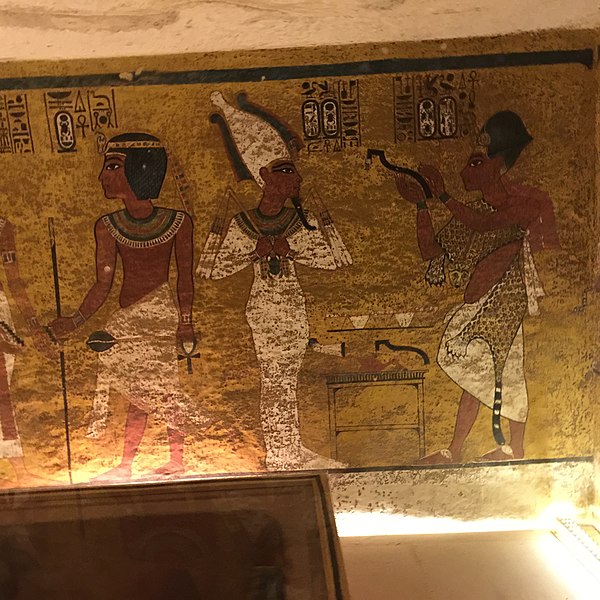
According to a reputable British Egyptologist, the finding of concealed hieroglyphics in Tutankhamun’s tomb supports the hypothesis that the legendary Egyptian queen Nefertiti is buried nearby in a secret chamber.
Although the notion remained unverified following inconclusive radar scans, Nicholas Reeves, a former curator at the British Museum’s Department of Egyptian Antiquities, argued that the new clue has given the issue new life.
Reeves discovered that cartouches of queen Nefertiti’s burial had been painted over by cartouches showing Tutankhamun being buried by his pharaonic successor, Ay. Nefertiti was the legendary wife of Pharaoh Akhenaten who was queen of the 18th Dynasty of Ancient Egypt.
Reeves said, “I can now show that, under the cartouches of Ay, are cartouches of Tutankhamun himself, proving that that scene originally showed Tutankhamun burying his predecessor, Nefertiti. You would not have had that decoration in the tomb of Tutankhamun.”
The later cartouches on the painted north wall depict Ay conducting the rite of “opening the mouth” of the mummy in order to revive the dead person’s five senses while holding a ceremonial adze.
Reeves says, “Close inspection of Ay’s cartouches reveals clear, underlying traces of an earlier name of Tutankhamun. In its original version, this scene had shown Tutankhamun performing the funerary ritual for the tomb’s original owner, his immediate predecessor Nefertiti.”
He added that “this conclusion finds absolute confirmation in the figures’ facial profiles—the snub nose and chubby under-chin of the [figure] currently labelled as Ay follow precisely the standardized facial outline adopted for official representations of Tutankhamun at the very start of his kingship. The face of the mummy carries the indisputable features of Nefertiti. Demonstrably, the scene had begun its life as a record of Tutankhamun officiating at the burial of his predecessor.”
Tutankhamun’s Tomb Stuffed with Furniture Needed in Afterlife
Tutankhamun’s tomb, which Howard Carter discovered precisely a century ago, was stuffed with furniture the kid king would need in the afterlife, including chariots and chairs.
Reeves contends that because of his untimely death in 1324 BC at the age of nineteen after only nine years as king he had to be buried quickly.
He said, “Not until a decade later, with Tutankhamun’s death, would the tomb be reopened and its outermost elements emptied and adapted to receive its cuckoo prince.”
He claimed that the new proof is consistent with the hypothesis that Tutankhamun’s tomb is only the outer portion of a much bigger tomb “made for and still occupied by” Nefertiti, whose own, independent series of funeral chambers lies beyond what is currently visible.
Although other scientists found that the scans were inconclusive, in 2015, Reeves claimed that lines beneath plastered surfaces of painted walls in Tutankhamun’s tomb indicated undiscovered doors.
He said, “It’s very easy just to write this off as sheer fantasy, but I’ve discovered that the decoration of the wall in the burial chamber had been changed. We’ve always been puzzled by Tutankhamun’s tomb because of its strange shape. It’s very small, and not what we’d expect of a king.”
Tons of archaeology work around Tutankhamun’s tomb
The New York Metropolitan Museum of Art is another institution where Reeves has served as a curator. He has done a great deal of archaeology work in and close to Tutankhamun’s tomb.
In his upcoming book, The Complete Tutankhamun, which Thames & Hudson will release on October 28th, he will present the fresh proof. It updates the highly regarded edition he initially released thirty years ago, which has been in circulation since.
He believes that current research, such as thermal imaging and analysis of mold growth, furthers his position.
He writes, “Far from Tutankhamun having been buried in the expanded, unused tomb of a private individual, it looks very much as if he [were] merely an interloper within the outer section of a significantly larger, queenly tomb…[This is] an unusual state of affairs…, but in fact the arrangement is far from unique.”
He cites Tanis as an example, where the burials of Psusennes I and Amenemope from the 21st Dynasty were found there complete and undetected behind a sliding stone wall with a similar decorative pattern.
He also clarifies how unevenly conducted radar studies since 2015 have been. “While those reliant upon automated filtering to remove extraneous ‘noise’ have declared that they see nothing in their results, others, processing the data in a more considered manner, perceive the north wall’s eastern half to indeed be construction rather than bedrock,” he said.
See all the latest news from Greece and the world at Greekreporter.com. Contact our newsroom to report an update or send your story, photos and videos. Follow GR on Google News and subscribe here to our daily email!



